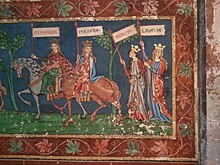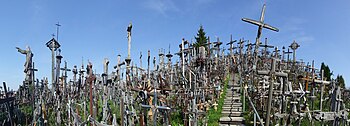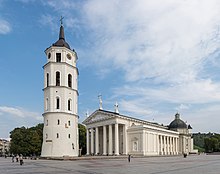Catholic Church in Lithuania

| Part of a series on the |
| Catholic Church by country |
|---|
 |
|
Catholicism portal |
The Catholic Church in Lithuania (Lithuanian: Katalikų Bažnyčia Lietuvoje) is part of the worldwide Catholic Church, under the spiritual leadership of the Pope in Rome. Lithuania is the world's northernmost Catholic majority country.[2] Pope Pius XII gave Lithuania the title of "northernmost outpost of Catholicism in Europe" in 1939.[3][4]
Among the Baltic states, Lithuania is the country with the highest percentage of Catholic population.[5] Almost three-quarters (74.19%) of Lithuania's population, self-identified as Catholics in the 2021 census.[6] The country is divided into eight dioceses including two archdioceses and a military ordinariate.[7]
History
Middle Ages (c. 1000–1500)
11th century
The missionary bishop Saint Bruno of Querfurt was martyred in 1009 for preaching the Christian faith.[9] Some historians write that he was martyred by the Lithuanians, but Zigmas Zinkevičius contests this and says that Bruno was killed in lands inhabited by the Yotvingians.[10] The name of Lithuania was mentioned for the first time due to this.[11]
13th century

Catholicism began to spread in Lithuania in the 13th century.
The ruler's baptism meant that Lithuania became an officially Catholic country that was internationally recognized already in the 1250s.
After Mindaugas' assassination, Treniota, who ruled Lithuania for about a year after rising to power in 1263, began persecuting Christians.[12] In 1264, after Treniota was killed, the Lithuania was ruled by Mindaugas' son Vaišvilkas (r. 1264–1267), followed by Mindaugas' son-in-law Shvarn (r. 1267–1269), who were both Orthodox.[12] The latter died during the struggle for power within Lithuania and the following Grand Dukes of Lithuania were pagans.[12]
14th century

During the 14th century, Lithuania's pagan rulers, for example, Vytenis and Gediminas, built Catholic churches and invited Catholic priests and monks to Lithuania.
Gediminas' rule (1316–1341)
Vytenis' successor, Gediminas (r. 1316–1341), who was also a pagan, formed an alliance with the Archbishop of Riga against the Teutonic Order.[12] Since the beginning of their first alliance in 1298, Riga's Franciscans and Dominicans could freely operate in Lithuania.[12] Later, the Archbishop of Riga Friedrich von Pernstein wanted to establish Franciscan and Dominican monasteries in Lithuanian cities, in which he succeeded.[12] In Gediminas' estates, Franciscans and Dominicans were active.[12] In Vilnius, two churches were built, with one being for the Dominicans and the other for the Franciscans.[12] There was also a Franciscan church in Naugardukas.[12] Encouraged by these monks and in the pursuit of political goals, Gediminas wrote a letter to the Pope in 1322 promising to become Roman Catholic.[12] In 1323, Gediminas wrote letters to the superiors of monasteries in Western Europe and invited priests, monks and lay Christians to come to Lithuania, while promising them freedom of religion.[12]
The Pope promised to send his legates to Gediminas in June 1324 and they arrived in Riga by autumn.[12] They sent their representatives to Gediminas, but he refused to be baptized and pretended not to know anything about his promise to be baptized.[12] He blamed this on the Franciscan who wrote the letter to the Pope.[12] Nevertheless, the monks continued to spread Catholicism in Lithuania.[12]
Co-rule by Algirdas and Kęstutis (1345–1377)

Gediminas's sons
In 1351, King
Emperor
Lithuanian Civil Wars (1381–1384; 1389–1392)

The Grand Dukes of Lithuania
With the
15th century

A delegation of

With the help of the rulers like Vytautas, Jogaila and others, the number of churches in Lithuania increased rapidly.[12] By the end of the 14th century, there were 17 churches in the Vilnius' diocese, of which 5 were in Vilnius itself.[12] According to the Polish historian Jerzy Ochmański, 10 parishes were established by 1392, with a total of 27 parishes throughout the Grand Duchy of Lithuania by the time of the death of Vytautas the Great in 1430.[22] By the end of 15th century, there were 109 churches throughout Lithuania, 91 in Vilnius' diocese and 18 or 19 churches in the Samogitian diocese, of which 7 were founded by Vytautas himself.[12][24] From then until the mid-16th century, 103 and 38 churches were built in the Vilnius and Samogitian dioceses, respectively.[12] Around 1500, there were 130 churches in Vilnius' diocese.[25]
While the dioceses were being established, churches were mostly built and founded by rulers, later by magnates and nobles.[12] In the foundations by rulers, land was usually assigned to the church, the income from which allowed the maintenance of parish clergy and buildings, while the foundations by nobles concerned funds and church supplies.[12] The noble founders of churches and their heirs usually also inherited the Jus patronatus, which ensured that the parish would be provided with a clergyman.[12]
Early Modern period (1500–1795)
16th century



In 1501, Erazm Ciołek, a priest of the Vilnius Cathedral, explained to the Pope that the Lithuanians preserve their language and ensure respect to it (Linguam propriam observant), but they also use the Ruthenian language for simplicity reasons because it is spoken by almost half of the Grand Duchy of Lithuania.[27]
In the 16th century, following the decline of Ruthenian usage in favor of Polish in the Grand Duchy of Lithuania, the Lithuanian language strengthened its positions in Lithuania due to reforms, including religious, which allowed lower levels of the
In 1530–40, the
During the
In 1569, due to the initiative of Bishop
The Cardinal Jurgis Radvila founded the
In the
17th-18th centuries
The construction of churches supported by noble founders and the establishment of new monasteries intensified very much during the 17th-18th centuries.
Long 19th century (1795–1914)

After the uprisings of
20th century
Lithuania regained its independence in 1918 and successfully defended it in the Lithuanian Wars of Independence. The Vatican recognized Lithuania's independence de jure in 1922.[9] A concordat was signed in 1927 between Lithuania and the Holy See.[9][20]
First Soviet occupation
After the Soviet Union occupied Lithuania in the summer of 1940, the Church began to be persecuted.[9][20] The Church and state were separated.[20] The concordat and diplomatic relations with the Vatican were terminated.[9][20] Church property was confiscated, religious education in schools was stopped, publishing of Catholic books and newspapers was banned.[9][20] Dominican monasteries were also closed down.[13] On 11–12 July 1940, many prominent Lithuanian public figures were arrested, including Catholic priests.[20] During the Soviet mass deportation from Lithuania on 14–15 June 1941, 9 Lithuanian Catholic priests were deported.[20] In the beginning of Operation Barbarossa in late June 1941, a total of 15 Lithuanian Catholic priests were murdered.[20] On June 22, priests Justinas Dabrila, Vaclovas Balsius and Jonas Petrikas in Būdavonė forest (Bartninkai district) were martyred by NKVD soldiers.[20]
Second Soviet occupation

During the
In the 1970s, the Catholic Church's underground activity intensified, as underground Catholic newspapers and magazines began to be published, and priests were trained underground.[20] In 1972, the underground publication Chronicle of the Catholic Church of Lithuania began to be published.[20] The number of initiatives to defend religious freedom increased.[9]
Also during the Communist time,
Hill of Crosses

The nationally renowned anti-Communist resistance
Independent Lithuania

Lithuania regained its independence once more in 1990, during the dissolution of the Soviet Union. The Catholic Church is an influential factor in the country, and some priests actively led the resistance against the Communist regime and, after independence was regained, in support of traditionalism, especially in ethical questions.[citation needed]
The Catholic Church in Lithuania has after independence continued to campaign against
The treaties of the Holy See and the Republic of Lithuania entered into force in 2000.[9] Since then, the relations between the Catholic Church and the Lithuanian state have been regulated by three special treaties of the Republic of Lithuania and the Holy See, instead of the concordat.[20]
Education
The Jesuits establish a college in Vilnius in 1570.
Hierarchy
| Holy See | |||||||||||||||||||||||||||||||||||||||||||||||||||
| Archdiocese of Vilnius | Archdiocese of Kaunas | Military Ordinariate of Lithuania | |||||||||||||||||||||||||||||||||||||||||||||||||
| Diocese of Kaišiadorys | Diocese of Panevėžys | Diocese of Šiauliai | Diocese of Telšiai | Diocese of Vilkaviškis | |||||||||||||||||||||||||||||||||||||||||||||||
- List of Apostolic Visitors for Lithuanian Catholics in Diaspora (historically, until 2003)
Catholic churches in Lithuania

The first churches appeared in Lithuania before the introduction of Christianity – they were built by merchants and craftsmen from other countries who lived here. After the baptism in 1387 the number of churches in Lithuania began to grow notably. In the middle of the twentieth century there were as many as 885 Catholic churches and chapels in Lithuania.[citation needed]
The first church in Lithuania, supposedly, was built by the Grand Duke
Catholic organizations in Lithuania
- Ateitis: Catholic children and youth organization, member of Fimcap[citation needed]
See also
- Religion in Lithuania
- Apostolic Nunciature to Lithuania
- Christianization of Lithuania
- Saint Casimir
- List of Catholic pilgrimage sites in Lithuania
References
- ^ "Lithuanian church voted most beautiful Catholic church in world". Lithuania Tribune. 7 March 2016.
- ^ Juergensmeyer & Roof 2012, p. 111.
- ^ Beeson 1982, p. 125.
- ^ "Pijus XII apie Lietuvą: katalikybės šiaurinis avanpostas – Vatican News" [Pius XII on Lithuania: Northern Outpost of Catholicism]. www.vaticannews.va (in Lithuanian). 2020-03-03. Retrieved 2023-02-16.
- ^ Stan & Turcescu 2011, p. 115.
- Department of Statistics (2021-12-21). "2021 m. gyventojų ir būstų surašymo pagrindiniai rezultatai". osp.stat.gov.lt (in Lithuanian).
- ^ "Catholic Church in Republic of Lithuania (Lithuania)". www.gcatholic.org.
- ^ Lithuanian Saints and Witnesses of Faith on the Official Page of Catholic Church in Lithuania
- ^ a b c d e f g h i j k l m n o p q r s t u v w katalikai.lt 2007.
- ^ Zinkevičius 2012.
- ISSN 0024-5089.
- ^ a b c d e f g h i j k l m n o p q r s t u v w x y z aa ab ac ad ae af ag ah ai aj ak al am an ao ap aq ar as at au av aw ax ay az ba bb bc bd be bf bg bh bi bj bk bl bm bn bo bp bq br bs bt bu Paulauskytė 2018.
- ^ a b c d Jagminas 2018.
- ^ vle.lt(in Lithuanian).
- ^ vle.lt(in Lithuanian).
- ^ a b c d e f Ališauskas 2006, pp. 25–27.
- ^ Zinkevičius 2000.
- ^ Boruta 1996, p. 257.
- ^ Boruta 1996, p. 258.
- ^ a b c d e f g h i j k l m n o p q r s t u v w x y z aa ab ac ad ae af ag ah ai aj ak al Aliulis 2006.
- ^ Ališauskas 2006, p. 50.
- ^ a b Ališauskas 2006, p. 61.
- ^ Ališauskas 2006, p. 66.
- ^ Ališauskas 2006, p. 69.
- ^ Ališauskas 2006, p. 68.
- ^ Fijał, Jan; Semkowicz, Władysław (1948-01-01). "Kodeks dyplomatyczny katedry i diecezji Wilenskiej. Tomu 1. Zeszyt 3 (1501-1507, uzupełn. 1394-1500) (W Krakowie 1948)". Codex Diplomaticus Ecclesiae Cathedralis Necnon Dioceseos Vilnensis. Voluminis I. Fasciculus 3 (1501-1507, Addenda 1394-1500).: 616–617.
- ^ a b c Dubonis, Artūras (2016). "The Prestige and decline of the official (state) language in the Grand Duchy of Lithuania (fifteenth-sixteenth century): problems in Belarusian historiography". Lithuanian historical studies. 20: 7, 21. Retrieved 3 November 2023.
- ^ a b c d e f Ivinskis 1953.
- ^ "Kryžių kalnas. Apie Kalną". Kryziukalnas.lt. Retrieved 4 March 2023.
- ^ "Kryžių kalnas". Visuotinė lietuvių enciklopedija (in Lithuanian). Retrieved 4 March 2023.
- ^ "Churches | Majestic Architecture With the Rich History". www.lithuania.travel. Archived from the original on 2014-12-30.
Sources
- Ališauskas, Vytautas, ed. (2006). Krikščionybės Lietuvoje istorija (in Lithuanian). Vilnius: Aidai. ISBN 9955-656-18-2.
- Aliulis, Vaclovas (2006-01-17). "Katalikų Bažnyčia". vle.lt(in Lithuanian).
- Beeson, Trevor (1982). Discretion and Valour: Religious Conditions in Russia and Eastern Europe. Fortress Press. ISBN 978-0-8006-1621-2.
- Boruta, Jonas (8 August 1996). "Iš Lietuvos Bažnytinės Provincijos kūrimo istorijos" (PDF). Laiškai lietuviams (in Lithuanian). XLVII (9).
- Paulauskytė, Teresė (2018). "Lietuvos Katalikų Bažnyčia" [Lithuania's Catholic Church]. vle.lt(in Lithuanian).
- Ivinskis, Zenonas (1953-10-08). "Lietuvių kalba viešajame Lietuvos 16–17 amž. gyvenime: žiupsnelis medžiagos iš Romos archyvų". Aidai (in Lithuanian).
- Jagminas, Leonardas (2018-08-10). "dominikonai". vle.lt(in Lithuanian).
- Juergensmeyer, Mark; Roof, Wade Clark (2012). Encyclopedia of Global Religion. SAGE. ISBN 978-0-7619-2729-7.
- katalikai.lt (2007). "Pagrindiniai krikščionybės Lietuvoje istorijos faktai" [The main facts of the history of Christianity in Lithuania]. Katalikų Bažnyčia Lietuvoje (in Lithuanian). Archived from the original on 2007-02-09.
- Stan, Lavinia; Turcescu, Lucian (2011). Church, State, and Democracy in Expanding Europe. ISBN 9780199714124.
- Zinkevičius, Zigmas (2000). "Mindaugo krikštas ir lietuviški poteriai". Lietuvių poteriai (in Lithuanian). Vilnius: Mokslo ir enciklopedijų leidybos institutas.
- Zinkevičius, Zigmas (2012-11-16). "Lietuviai ir krikščionybė". XXI amžius (in Lithuanian). 43 (2018).
External links
- Katalikų Bažnyčia Lietuvoje / Catholic Church in Lithuania
- Official web site of Lithuanian Catholic Church
- Sanctuaries and Pilgrimage Sites in Lithuania
- Herbermann, Charles, ed. (1913). . Catholic Encyclopedia. New York: Robert Appleton Company.
